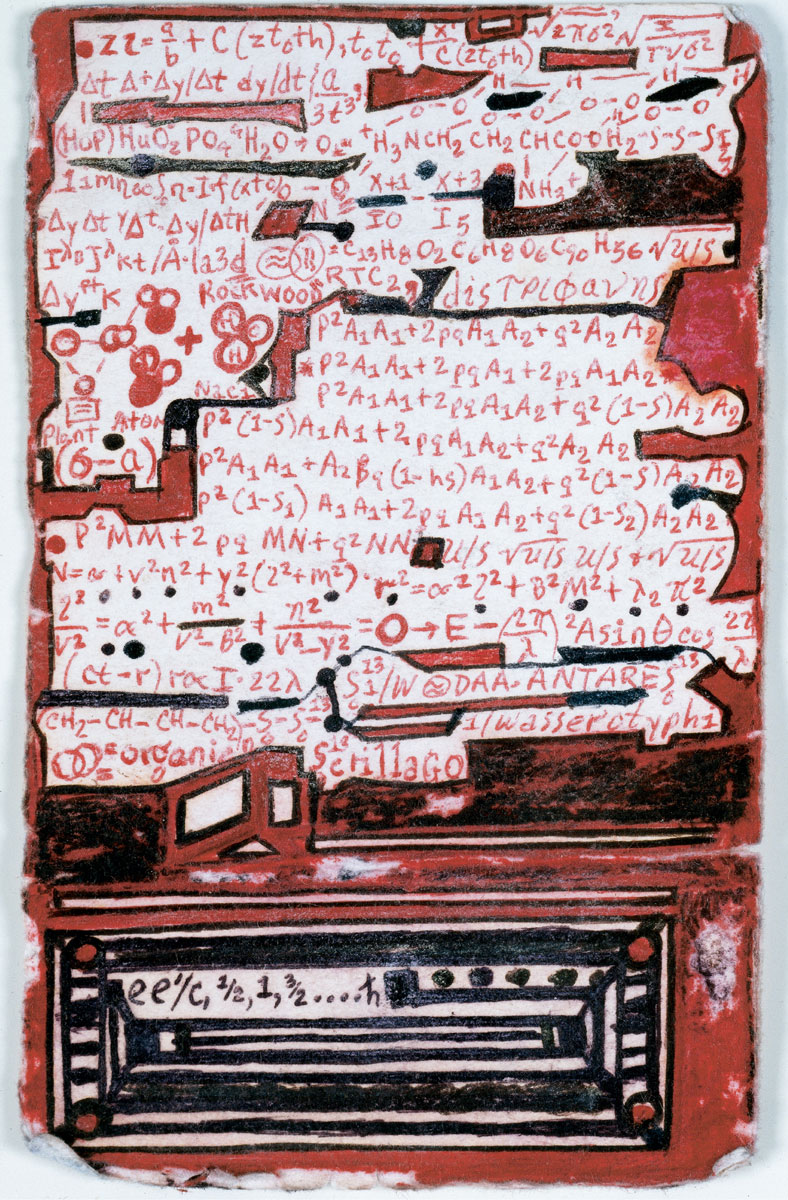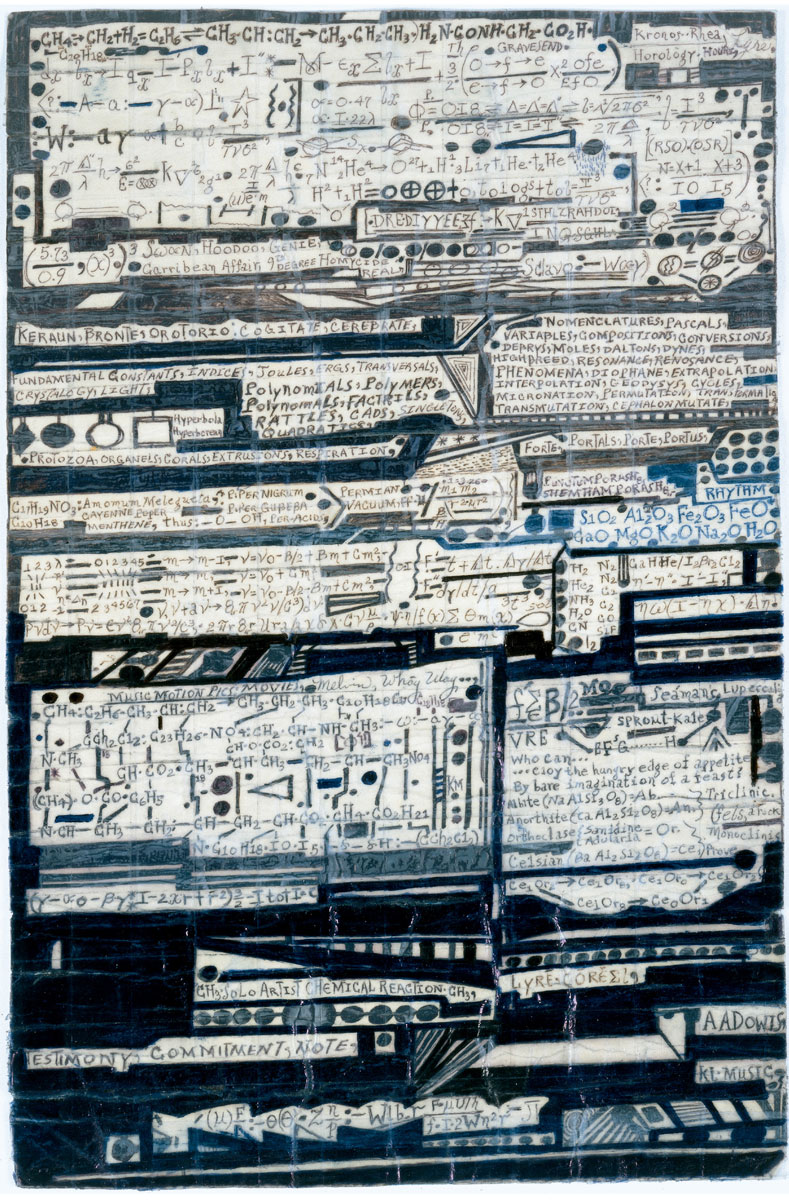Algebra Is Drunkenness
Melvin Way’s poetics of the ad infinitum
Allen S. Weiss

Adolf Wölfli (1864–1930), arguably the most famous of schizophrenic artists, describes his smallest diamond as weighing 28 million tons.[1] Its value is incalculable (though Wölfli never hesitates to calculate the unthinkable, covering pages and pages with giddy computations), its weight crushing (but isn’t this already a triple source of power: financial, aesthetic, physical?), its possession megalomaniacal (the sort of cosmic hyperbole that characterizes much art, theology, paranoia). Here, the imagination overcompensates for a state of nearly total social dispossession and psychological disequilibrium. The fantasy of such a diamond is a strategy of survival and a trace of creative joy in an otherwise bleak universe. It stands for ecstatic proliferation, a numerological dream of order-within-chaos, an intoxication of the mind by the mind.
There is a poetics of the ad infinitum, a self-hypnosis founded on the charms of parataxis raised to the power of infinity. As such accumulations reach the point of the incomprehensible, they transform aesthetic sentiments: we call this cognitive disarticulation, and dissonance the sublime. What the golden section is to beauty, the infinite is to the sublime. The very large or very complex, for most intents and purposes, serve as tantamount to the infinite, and given the representational limits of human knowledge, attempts to emblematize the incommensurable take refuge in the implication, rather than the description, of enormity. Symbols for the limitless—that which is above all calculation—may be variously constituted by the fingers of one hand, or two hands, or two hands plus two feet, or a specific figure like the numerical value of God [18] in Jewish symbolism, or the ten thousand things of Chinese philosophy, or the disconcerting trente-six [36] that the French use to designate great quantities. The essence of the sublime thus changes with every culture and every epoch; perhaps ours has become the streaming 01010 of digitalization, or the ACGT strings of nucleotides that comprise all DNA. Entrapping the absolute within quantifiable confines seems to have perennial charm, and the fact that digitized or genetic code touches on a reality that can be measured and verified, while Wölfli’s diamond cannot, does not alter the fundamental poetic link between them.
A contemporary master of the mathematical and molecular sublime is New York artist Melvin Way, whose drawings of chemical and numeric equations celebrate the ecstatic power of self-propagating structures. Way’s obsessive inscription is a picture of calculation, not calculation per se; in his art, both the formal lineaments of scientific notation and the limits of the infinitesimal sublime are revealed through their aesthetic simulacra.
As such, Way’s drawings constitute a rare manifestation of the mathematical sublime as black humor, the acerbic and hermetic humor of the dispossessed. In these works, where drama is couched in the form of arcane formulas, calculation = sublimation, spectacle = performance, equation = icon, prescription = representation. Way has been classified as an “outsider” artist; we might wish to revive the 19th-century category of the poète maudit to further refine this qualification—though it is the milieu, rather than the artist, that should properly be termed “accursed.” In a cruel world where surviving urban chaos is—especially for the disenfranchised—often a matter of chemical reactions (recreational or medicinal), and where there is a constant danger of viral infection (biological or cybernetic), the best protection from imminent catastrophe may be that strategy of first and last resort, the imagination. Formulas are used to control the world, not unlike magic spells. Might not the work of Way contain a phantasmatic pharmacopoeia that offers homeopathic cures for real addictions and pains? In Way’s world, exclamation is interruption: his counting and calculating, his “math” and “chemistry,” shock us into the recognition that what connects (indeed, what constitutes) us all is the unspeakable complexity of numbers and atoms, chemical reactions and genetic structures—the infinitesimal side of infinity that theologians after Pascal have so hazardously neglected.
Wölfli insisted that “Algebra is music,” and Baudelaire that “Drunkenness is number.” We have known, ever since Pythagoras, that music is number, and that the music of the spheres is a sort of celestial algebra. To further factor out this aesthetic theorem, we might add that Melvin Way reveals the converse: algebra is drunkenness.

- The critical literature on Adolf Wölfli is vast; one of the most inspiring studies is by Harald Szeemann, “No Catastrophe without Idyll, No Idyll without Catastrophe,” in Elka Spoerri, ed., Adolf Wölfli: Draftsman, Writer, Poet, Composer (Ithaca, NY: Cornell University Press, 1997), pp. 124-135.
Allen S. Weiss has been working hard on ingestion: He recently co-edited French Food (Routledge), and his Feast and Folly is forthcoming (SUNY).
Spotted an error? Email us at corrections at cabinetmagazine dot org.
If you’ve enjoyed the free articles that we offer on our site, please consider subscribing to our nonprofit magazine. You get twelve online issues and unlimited access to all our archives.